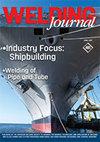Arc Characteristics and Welding Process of Magnetic Field Assisting Plasma-GMAW-P
IF 1.4
3区 材料科学
Q2 METALLURGY & METALLURGICAL ENGINEERING
引用次数: 4
Abstract
Low-carbon steel Q235B was successfully joined by plasma-pulsed gas metal arc welding (plasma-GMAW-P) with an external magnetic field. The arc profile, temperature field, electrical signal, microstructure, and mechanical properties of this method were analyzed. The results indicated that the coupling degree of the two arcs increased with the strengthening of the magnetic field current. However, when the magnetic field current was greater than 1 A, the arc pro-file changed slightly with the increase of the magnetic field current. Fixed on the magnetic field current, the coupling degree first increased and then decreased with the increase of the plasma welding current, GMAW-P welding current, plasma gas flow rate, and nozzle height, respectively. The maximum temperature had no obvious influence on joint penetration at different magnetic field cur-rents. However, the average temperature had an inverse effect on joint penetration at different magnetic field currents. The weld fusion zone joint tensile test results showed that the ratio of depth to width increased with the application of magnetic field currents. Moreover, tensile strength on the upper and lower part of the tensile samples were 521 and 488 MPa, respectively, which were 4.6% and 3.2% higher than those without the magnetic field. The microhardness of the weld joints was higher than that without the magnetic field.磁场辅助等离子体- gmaw - p电弧特性及焊接工艺
采用外磁场等离子体脉冲气体金属弧焊(plasma-GMAW-P)成功连接了低碳钢Q235B。分析了该方法的电弧轮廓、温度场、电信号、显微组织和力学性能。结果表明,随着磁场电流的增强,两弧的耦合度增大。而当磁场电流大于1 A时,随着磁场电流的增大,电弧轮廓变化不大。在磁场电流固定的情况下,随着等离子体焊接电流、GMAW-P焊接电流、等离子体气体流量和喷嘴高度的增加,耦合程度先增大后减小。在不同磁场电流下,最高温度对接头穿深无明显影响。而在不同的磁场电流下,平均温度对接头穿深有相反的影响。焊缝熔合区接头拉伸试验结果表明,随着磁场电流的施加,深度与宽度之比增大。拉伸试样的上半部分抗拉强度为521 MPa,下半部分抗拉强度为488 MPa,分别比未加磁场的试样高4.6%和3.2%。焊接接头的显微硬度高于无磁场的焊接接头。
本文章由计算机程序翻译,如有差异,请以英文原文为准。
求助全文
约1分钟内获得全文
求助全文
来源期刊

Welding Journal
工程技术-冶金工程
CiteScore
3.00
自引率
0.00%
发文量
23
审稿时长
3 months
期刊介绍:
The Welding Journal has been published continually since 1922 — an unmatched link to all issues and advancements concerning metal fabrication and construction.
Each month the Welding Journal delivers news of the welding and metal fabricating industry. Stay informed on the latest products, trends, technology and events via in-depth articles, full-color photos and illustrations, and timely, cost-saving advice. Also featured are articles and supplements on related activities, such as testing and inspection, maintenance and repair, design, training, personal safety, and brazing and soldering.
 求助内容:
求助内容: 应助结果提醒方式:
应助结果提醒方式:


